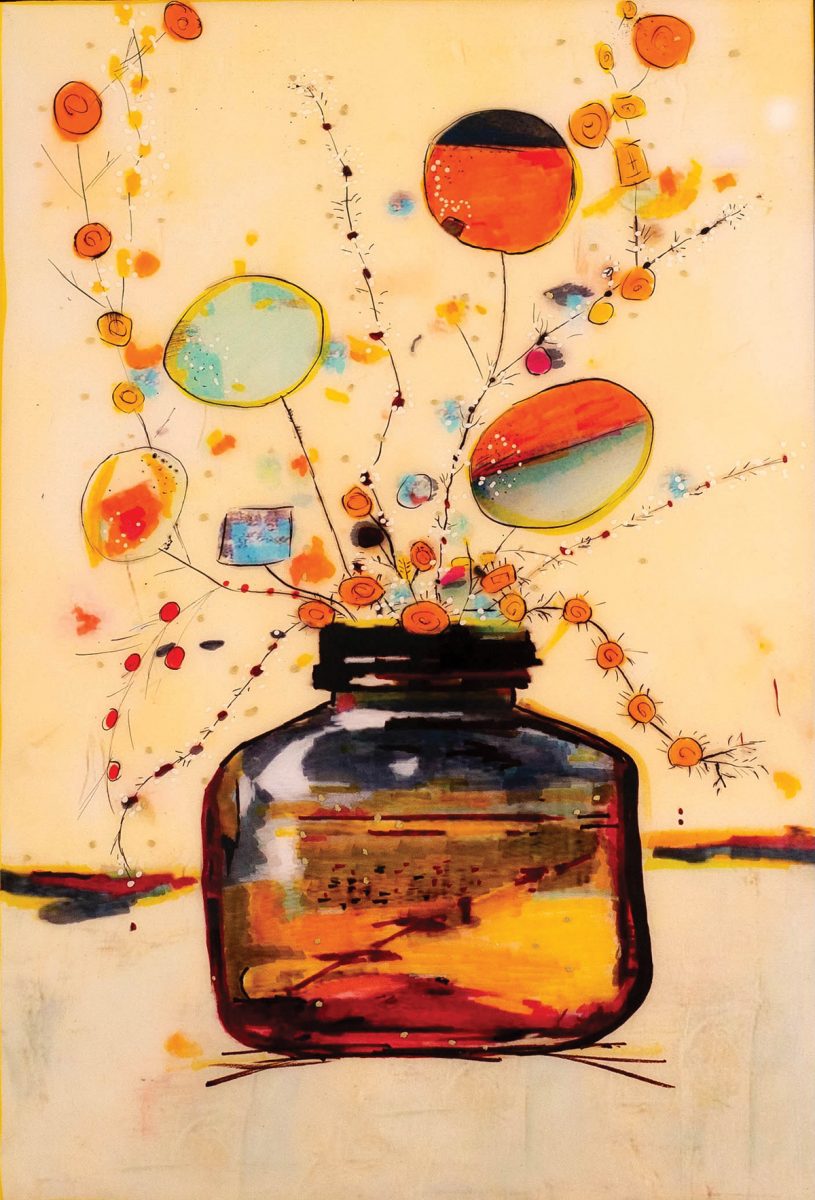Encaustics artist declares devotion to one medium

Michelle Hamilton, posed with her work displayed behind her, is inspired by travel and by folk art.
Photo by Rachel Pressley
Mchelle Hamilton doesn’t remember the first time she encountered encaustics — just that the meeting seemed long overdue.
“I thought, ‘Where has this been my whole life?’” the Asheville artist remembers. “‘And why am I just discovering it now?’”

Since that moment, Hamilton has produced a series of mostly nature-based work in a medium known for its ability to absorb and layer color and to yield to any amount of surface texturing. Hamilton’s fanciful animal portraits glow with the jeweled colors of stained glass, while her abstract work displays the medium’s genial cohabitation with oil paint and any number of found objects — buttons, scraps of metal, or whatever catches Hamilton’s eye. “I’m a collector of stuff,” she admits.
Mostly self-taught, Hamilton remembers drawing and painting as a child growing up in Florida. “I’ve traveled a lot, though, for art classes over the years,” Hamilton says. These explorations have led her overseas and to exposure to a variety of cultures and traditions in art. “The travel energizes me. I love folk art, so that genre really inspires me.” Much of her work has the whimsy and elusiveness of folk traditions, but without the flat planes and simple brushwork of that lineage. Instead, encaustic’s depth of color and tactile possibilities give rise to Hamilton’s endearing multi-colored pigs, bears, birds, and giraffes and to her heavily worked abstracts. “I guess my favorite thing about the medium is how it accepts all other kinds of mediums,” Hamilton says, from pastels to oil paint — even powdered casein, the main protein found in milk and cheese.

Hamilton’s work in encaustics (the name derives from the Greek for “burning in”) places her in the realm of one of the art world’s oldest mediums, stretching from the Faiyum mummy portraits of 2nd and 3rd century Egypt through Byzantine religious iconography to Jasper Johns’ 1955 Flag, for which he dipped strips of newsprint in hot wax. The technique had fallen out of favor before Johns and others rediscovered it and brought it back to the mainstream. Johns’ folk-art-inspired work is one source for Hamilton’s own pieces, although, magpie-like, she cites anything from Japanese fashion to the films of Tim Burton as potential catalysts for her creations.
The medium is not without its challenges. Practitioners in encaustic have to deal with blow torches and heat guns to melt the wax, chemical-based pigments to create a personal color palette, and an array of tools from hot irons to heat lamps to fuse and bind colors and layers.
“You’re dealing with very hot things and could get hurt,” she confirms.

Wood is the common substrate for the hot wax, which Hamilton shapes, smooths, and texturizes with spatulas, knives, and scrapers as the wax cools.
Once the wax is liquid, “the melted paint just glides over my substrate,” she explains, “and then I take my blowtorch and smooth it out to perfection. It can be testy at times, but I think over the years I’ve worked through those issues.”
Hamilton’s devotion to encaustic has grown even stronger since she moved with her husband to Asheville 20 years ago and got closer to nature. “Florida was just too hot for me,” she says. “We came up on our sidecar motorcycle and camped and drove on the Parkway. And after that, we said, ‘Yes! This is perfect for us!’”

Not long after settling in the mountains, Hamilton found studio space in Asheville’s River Arts District and its Trackside Studios.
Although Hamilton occasionally works in resin and acrylics, encaustic — with its versatility and workability — remains central to her artistic development. “I try not to let myself become limited to one particular theme because I want to be mutable in my creativity, always growing and changing along with my work. But after exploring many different mediums, encaustics is the most inspiring.”
And she likes to share that inspiration.
“I love teaching,” the artist enthuses. “The excitement when somebody has learned a new technique or discovered a medium they didn’t know how to work with is very pleasing. I would most definitely recommend this medium for anybody.
“But if you’re just starting out, I would take some classes.”
Michelle Hamilton, Asheville. Hamilton’s studio is located in Asheville’s River Arts District at Trackside Studios (375 Depot St., tracksidestudios375.com), and she shows work and teaches classes at Art Play (372 Depot St.; check artplay-studio.com for a list of fall offerings). Hamilton’s work is also sold at K2 Studio in downtown Asheville (59 College St., k2furniture.com); at Seven Sisters Craft Gallery (119 Broadway Ave., Black Mountain, sevensistersgallery.com); and atWood Berry Gallery (66 East Main St., Saluda, on Facebook). Also see michellehamiltonart.com.
